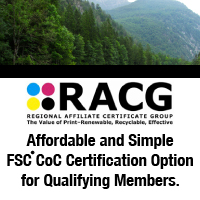
Nov 6, 2017 | Sales & Marketing

By Joe Rickard
Getting in front of senior executives can quickly change the future of a salesperson or a printing company. There is no better way to quickly develop and generate large sales than to gain access to senior decision makers.
Great printing salespeople can impact decisions about strategy, budgets, and marketing that are driven by senior levels of management. Many of these decisions cannot be found in the purchasing or department manager levels.
Executives want to talk to salespeople who can help them address their “big” problems and opportunities. For salespeople, that requires confidence, a thorough knowledge of graphic and digital communications, and an ability to bring creative ideas to their customers.
There are two great outcomes of an executive sales call: one is to gain agreement that what you have to offer is valuable to the executive’s organization; and two, the executive opens the organization to further sales meetings.
FIVE STEPS FOR A GREAT EXECUTIVE MEETING
1. Preparation It may take hours of preparation to gain just one great meeting with the right executive. It is worth it. The first challenge is to identify those CEOs, presidents, division presidents, and executive VPs in each targeted account. Having detailed information about their company, its objectives, its campaigns, and programs will increase the likelihood of success in securing the first meeting.
With gatekeepers blocking the way, and the likelihood that the target will not pick up the phone, a brief and impactful talk track to generate interest must be prepared in advance. In a few cases, the executive may actually pick up the phone. A short crisp message and a simple request for a meeting is the best strategy.
2. A Great Entrance A great first impression is vital. Though rapport building is important, keep the superficial banter to a minimum. Executives are looking for information and expertise. A professional appearance and demeanor will help. Briefly state your purpose, a brief overview of why you are there, and what you expect from the meeting. Make sure you share amount of time you will need for this meeting. Then just ask, “Is this okay with you?” A confident start will establish a solid foundation for the rest of the sales call.
3. Share the Dream Once the stage is set, it is time to share what you have discovered about the customer and their problems. You can do this by using facts and research on issues being faced by similar organizations and sharing them in a tailored way.
For instance, as part of your story to a hospital executive looking to expand their services, you could say, “According to the Direct Marketing Association, 83% of people find direct mail easier to absorb than email. We have found that our hospital clients who integrate direct mail along with their digital communications have increased their ability to sell additional and new services to their patients.”
Be prepared to share your case studies on how specifically you have helped similar organizations. By sharing facts about how your company and printing has helped other companies improve their performance, potential customers will want to hear more.
Then follow up with questions like this:
“How are you currently marketing your new clinical services?”
“What is the strategy of the hospital to attract new patients?”
“How will you address the new trends in the market?”
By asking probing questions, listening and letting the customer talk about the company and their priorities, the executive will become part of the sales call. Creating an optimistic vision for the customer will allow the discussion to continue.
4. Sync Up and Discuss Linkages Now is the time when the salesperson connects what has been discussed by the customer to how your company can help. By tailoring and summarizing the key points of the customer’s problems, you will be able to link what you sell to what the customer needs. A good exchange of ideas and agreements on how the salesperson can help the customer will lead to a close.
5. Close for an Open Door The final step is to gain agreement on what needs to be done next. It is rarely the time to close for an order. It is an opportunity to gain the executive’s endorsement for access to key influencers and stakeholders who are involved in the decision chain. The ideal goal is an open door to developing a well-qualified recommendation to visit other departments and staff. Since it often takes much time to gain a good meeting, preparation and execution is paramount. There may never be another chance to get a second meeting.
There has never been a time in recent history where it has been as important for printing salespeople to raise their level of contact within their customer organization. There is so much change in how printing can impact a customer’s top and bottom line that executives will welcome a meeting with a knowledgeable salesperson.

Feb 15, 2017 | Sales & Marketing

by John Raithel, President of Colorbar, Inc.
With the challenges of a slower growing economy, salespeople are under increased pressure to sell more work and at better margins. Increased sales performance pressures can and often do rush salespeople through the sales process and mistakes are made. In haste, they fail to fully plan for the sales call and how best to approach their prospect or customer visit. An area that is often overlooked by salespeople is; how will the purchaser perceive or feel about the sales visit? Feeling Empathy.
But is it even possible for salespeople to feel empathy for their customers when their own burden is so great? Yes, it is, and essential to sales success. But what does empathy mean? Webster’s definition is “the capacity to understand or feel what another person is experiencing from within the other being’s frame of reference, i.e., the capacity to place oneself in another’s position”.
Sales trainers touch on the idea of empathy but somewhat miss the mark. Their message for sales success is to be a good listener, find client issues and offer solutions…consultative selling. I agree these skills are very important, but they are not at the core of long-term sales success. Empathy is.
To achieve lasting success, sales professionals must understand and feel what their client is experiencing. They must adapt quickly to their client’s changing frame of reference, and since no buyer or sales situation is ever the same, salespeople need to focus on the skill of feeling empathy.
Empathy comes naturally to some people, but for others it requires more attention and thought. This doesn’t mean that one person is more genuine or better than the other, as long as the capacity to understand or feel what another person is experiencing from within the other being’s frame of reference is achieved.
While researching and preparing for a sales call, think about how your customer may view your findings. Make a list of questions to ask your client that will give you insight on how they feel and think and listening to their answers will give you a better understanding of their world. Also, keep in mind, people in the same organization don’t feel the same or have the same objectives and motivations, or even view problems the same. Your goal is to better understand how each person you are interacting with feels.
Here is just a small list of thoughts that may help you better understand your customer. There are many more that may fit better for you.
How is their day going? Not just your standard meet & greet question “how ya doing?” but are they focusing on your sales visit or is it elsewhere?
Are they feeling appreciated, burdened and overworked?
What is expected of them? Not just their job description, but from their company, themselves.
How are they evaluated? What are their goals? What do they have to deliver to get recognition, promotion or financial reward? What is their company culture? How do they view vendors? Does their personality and business style match their company’s culture and position? By not having empathy for your buyer, they won’t trust you to share their real problems. By not understanding what challenges your customers have, most likely your solutions will be wrong. You can’t just ask them what their problems are unless you first built a trusting relationship built on empathy. If you do, most likely the problem they have is…”the price is too high”.
So, understanding your buyer’s frame of reference is key to becoming a trusted advisor and achieving long-term success. Pre-sales call preparation is the key, even for existing customers. Changes happen quickly today so never assume. Researching companies and people is a lot easier today with social media websites, but don’t let that be your only source. These sites can provide a great deal of information. Company websites tell a lot about the organization by how it looks, etc. When researching buyers, stroll down on their LinkedIn page to see what organizations they follow or groups they belong. How many 1st connections do they have? Remember you’re trying to get a better sense of who they are as people and the culture they work in. Talk to people who may have experience with them. Has your company done business with them in the past, maybe with a different origination? Anything to help you prepare to see the world through your customer’s eyes.
Don’t try to solve problems unless you know for sure that’s what the buyer wants. People don’t always want you to solve their problems. Their employment may exist because of company’s problems and feel threaten when a vendor offers to fix them. You are there to sell, if fixing a problem helps in that goal, great, consulting is a solution.
Don’t assume your technology or efficiencies are important to buyers. Technologies, efficiencies and equipment may be important to some but not to others, even within the same organization. Remember each person in a purchasing role or a purchasing influencing position sees the vender/buyer relationship differently.
Also, don’t mistake how you feel about purchasing it is how others do as well. Not placing yourself in the shoes of your customer will cost you business. Buyers lean to their comfortable buying style, but can and do change according to their internal situations. What worked with them in the past, may not work now, so keep current with your buyers and their companies.
Being a sales professional is a great and rewarding career, but to have long-term success a commitment to constant improvement and empathy is needed. If the commitment to this is lost, soon, so will be the customers. With experience, training and continuing education, you will achieve great success, but always remember, as a strong building starts with a strong foundation, so too must a sales person start with empathy.
About the author: John Raithel, President of Colorbar, Inc. jraithel@colorbarinc.com

Mar 3, 2016 | Sales & Marketing
By Joe Rickard

Knowing who will make the decision to buy printing products and services is a key step in any sales process. Countless hours in sales time and frustration can be saved by quickly sizing up an account and learning how buying decisions are made. Though there is no magic formula, there are some simple steps salespeople can take to ensure they are working with the right people and not wasting valuable time.
Determining the decision process starts with learning who has the authority to make the final decision, who is a driving force and who will actually execute the proposed offering. Though the decision process varies from company to company, the buying of print always starts with a problem. The bigger the problem the more people will be involved in the decision.
Categories of Decision Makers
Sorting through the multitude of potential players who affect the decision process takes time and skill. The decision process for print-related offerings can be organized around five general categories. For many large sales, each of these categories of customers will need to be engaged. For smaller accounts, these categories of decision makers are often combined.
- Tire Kickers and General Time Wasters: These are the folks that can’t make or won’t make a meaningful buying decision. It is best to identify these people and politely avoid them.
- Influencers: There are plenty of potential influencers around decision makers. Recognizing who has influence and then gaining their support will minimize wrong sales steps. Most buying decisions will have multiple influencers.
- Champions and Mobilizers: These are folks that are vital. Without an influential person who supports you and your offering, there will not be a sale.
- End Users: For every decision, there is someone in the organization who actually implements and manages projects. Never overlook this role in the decision process. They may not be able to say“yes”but can certainly say“no”to a proposed solution.
- Decision Makers: Finally, there are individuals or groups of individuals who actually have the final operational and financial decision-making authority. Depending on the type and size of offering, they can be senior executives, middle managers or end users.
- Gatekeepers: Additionally, often there is a gatekeeper to contend with. A gatekeeper is a person who permits salespeople to talk to decision makers or influencers.
Multiple Decision-Making Processes in the Same Account
We recently worked with a large retailer to help them construct a company-wide Request for Proposal (RFP) for printing products and services. The company uses multiple printers for a variety of work. We counted at least four different decision processes based on what was being bought. For instance, in one case, a print buyer was responsible for the purchase of a substantial set of defined printing products that included point of sale, price books and promotional materials. In another, the customer bought direct mail services where the decision came from the marketing communications department.
Here are three ways to gain insights on how decisions are made:
1. Customers, Colleagues, Friends, and Family
When an opportunity presents itself, determine anyone who is or has been connected with this account. This takes creativity and a little time. Being able to reference another person to a targeted customer contact opens doors and enables the gathering of critical information to guide the sales process. Printing is still a relationship business.
In existing accounts, salespeople must relentlessly expand personal contacts and relationships. Incumbent salespeople always have the advantage in knowing how decisions are being made. Over time, it becomes apparent who are those champions or mobilizers who can help guide and drive sales efforts.
2. Social and Personal Networking
If there are no relationships at the targeted account, networking into the decision circle is the best approach. Using Linkedin and other networking channels to ask for help to gain access to decision makers is a good approach.
Take time to research each name provided by networking contacts to ensure you have the right messages, interesting opening statements and insights to share when you make contact. Having a name for a reference and specific knowledge into the customer’s business can help get through to busy decision makers.
3. The Last Resort
When all else fails, the cold call is the last option. Though it is the least productive in selling complex printing products and services, cold calling may be the only way to get into an account. We recommend being straight- forward and direct. Simply asking who is responsible for making decisions on direct mail or marketing communications is a good place to start.
Joining groups online and industry associations is also a good way to find contact names and insights into a customer’s business. This is a good way to move a very cold call to a warmer one.
Before moving through any sales process or forecasting deals, it is a good practice to ensure that the decision process is clearly understood. Failure often results in wasted time and effort. The chances of consistently being successful selling high relationship offerings associated with printing are greatly enhanced by simply knowing who are actually making the decisions.
About the Author: Joe Rickard is the founder of Intellective Solutions. Intellective Solutions (www.intellectives.com) works with printing and technology organizations to improve their sales, marketing and operational effectiveness. Joe can be reached at 845 753 6156. Follow him on Twitter @joe.rickardis.

Feb 2, 2016 | Sales & Marketing
But Our Customer Relationships Must!
By Dick Rossman

In one of Dr. Ronnie Davis’ PIA Economic and Print Market and Flash Reports, he pointed out two interesting marketing metrics. First, our largest single customer accounts for nearly 19% of our total business and our largest 5 customers provide nearly 40% of our business. And second, over 60% of printers in the US have a market focus of less than 100 miles. So we continue to be an industry that does business fairly locally and where we rely on large accounts which are close to our manufacturing facilities. But while our customers may still prefer to be near their print suppliers, how they want to manage their print communications and what we need to know about them is definitely not as it once was.
We all know the importance of having great customer service. But today great customer service also means providing an easy way to store, design, change, order and pay for print communications material with an online web-to-print capability that is easy for our customers to use. I recently spoke with a VP of Sales and Marketing at a large NE printing company. He said that they want their customers to call or email them about everything. Ordering online was anathema to them as it eliminated the contact with their customers that they so religiously sought out. But customers today, whether local or not, want to simplify their lives, reduce unnecessary communication, speed up the production process, and see results quicker. Providing an online print products management solution for your best customers is part of the new definition of great customer service.
Second, in the past it was enough for us to understand the nature of the jobs that our largest customers wanted us to print: sizes, number of pages, stock, frequency, delivery requirements, etc. Today we need to know not only what they want to print but why. We should be learning first about the industries that our customers are in and second about how our customers do business in that industry. How do they generate revenue, who is their competition, who are their customers and how do they find more of them, what is the nature and purpose of their marketing communications, etc.? By becoming an expert in their businesses, we are then in a position to be not just an order-taking sales person but an advisor in providing the print and marketing solutions that we offer.
While the metrics about our customers may not have changed, how we service them and what we need to know about them certainly has. The companies who are growing today are those that recognize this and have developed the technology and the sales mindset to make these adaptations. Their 5 largest customers have recognized this also and are providing them even more business than ever.
Jan 2, 2016 | Sales & Marketing Technology
By Charles Groce, CEO Pearl Street Consulting
I recall back in 2009 while working as an IT manager at a commercial printing company which handled a lot of publication work how excited we were to start offering our customers “flip-book” or “eZine” versions of their printed publications. This was, we thought, really getting into the business of internet publication. And the best part of it all was that we could obtain flip book licenses at a relatively low cost and without much additional work added on to our prepress workflow, allowing us to tack on another invoice line item. It was great! We didn’t even need a web designer!
Then came the rise of the smart phone, with some 35% of internet users today only consuming online content on their mobile devices. PDFs designed for printed publications, whether in flip book format or whether read simply using a PDF reader, didn’t provide a pleasant reading experience on mobile because of the multiple column format of most well-designed publications. Users of smart phones simply do not want to zoom in to read and zoom out to navigate. Consumers of content get a much less distracting reading experience with the mobile responsive web, which automatically formats text and graphical content as single-column while maintaining a look consistent with the full web version.
The undeniable importance of web and mobile publishing today begs the question: Is it possible for publishers and their partners in the printing industry to start with a workflow strategy which begins with content intake and produces from this process not only a fully designed printed publication, but also a mobile-responsive web site, and perhaps even email marketing content?
The answer is yes, of course. We could just add more people to the process. But money is made when processes are done efficiently, and in the world of digital information this means leveraging software intelligently to create workflow automation.
I’ve written a lot about open source solutions and how they can satisfy a whole range of operational needs for companies in the printing industry. Open source technology can also be used to vastly extend the reach of publication content, and this can benefit both printers and content creators alike.
Think about it. Many magazine publications in the abstract are really just a set of articles, each of which represent one of the many goals of the publishers. In academia, this goal may be recruitment to individual programs like nursing or film making. In business, publication content may be promotional in nature and designed to attract new customers. On behalf of institutions, content may be more informational in design.
Regardless of the end goal of content, in the internet world, each of these articles would necessarily have their own associated URL or web link, allowing users to consume ideally only the content in which they’re interested.
Article URLs can then be posted to and promoted on social media channels like Facebook. Social media channels offer unparalleled demographic targeting and tracking capabilities, two things not yet fully realized in print + direct mail, allowing content distributors the ability to deliver articles to a much more granular audience than can be offered by saturation mailing. The result is a very powerful, affordable way to target the right audience with the right content.
Email marketing offers similar benefits, with link tracking and targeting capabilities inherent in the more popular email marketing platforms. All of these require reformatting and re-purposing the original content for each platform.
You may be thinking this all sounds great but it also sounds enormously time consuming and expensive! Your graphic designer may not have the time to format all that content for the web, for email consumption, or for social media. Your graphic designer may not even know HTML!
But with technology, in business anyway, anything is possible. And the one thing you can count on is that a more efficient way of doing things will eventually arise out of the production process. Open source, community built solutions exist today which will allow the conversion of a print-centric, traditional content intake workflow into something more flexible, automated, and efficient at zero dollars in licensing costs. Such an extension of publication content (content which took a lot of work to produce in the first place!) vastly extends the reach of your publication message.
And the benefits of taking a content-first approach to publishing aren’t just limited to just publishers. Printers who offer these capabilities to their publication customers will find that their customers no longer think of their company as simply another provider of printing services. Rather by providing these value-added services, printing companies become more and more partners to publishers. More services strengthens the vendor-publisher relationship and helps ensure it will last longer. Offering these types of value-added services to publishers at low cost by utilizing technology means printing companies can actually make money doing this.
About the author: Charles Groce is the CEO of Pearl Street Consulting, a Michigan-based IT, web, and software consultancy. Charles is also the owner/operator osforprint.com, an open source technology solutions provider for the printing industry.

Jan 2, 2016 | Sales & Marketing
By Joe Rickard, Intellective Solutions
 Spending many hours researching and writing about the transition taking place in B2B direct selling, I have found that the value of networking and relationships still remain paramount. More than a few Decembers ago, I remember a specific deal where a relationship of my father-in-law helped me finish the year strongly.
Spending many hours researching and writing about the transition taking place in B2B direct selling, I have found that the value of networking and relationships still remain paramount. More than a few Decembers ago, I remember a specific deal where a relationship of my father-in-law helped me finish the year strongly.
After a promotion to sales manager for a Manhattan-based team of savvy and seasoned pros, I was faced with a dilemma. My sales team was reluctant to share information about their prospects or bring me in to meet their large prospects. It seemed they were testing their new and young sales manager. At this time, members of my sales team were engaged in a very large sales opportunity at a prominent publishing company. Because of the size of the deal, it had high visibility in my company. My boss repeatedly quizzed me on the status of the prospect. An order here would immediately propel my sales team and me from mediocrity to stardom.
I understood we had strong support and agreement from within the account. The barrier according to my salespeople was gaining agreement from a tough VP of Finance, a long-term employee who had a reputation akin to “Attila the Hun”. Not only was my team terrified of him, but the account’s employees were as well. Nothing of significance was ever approved without a scrupulous and contentious review by this tyrannical VP. One member of my sales team suggested we wait until he retired.
Over a weekend, my retired father-in-law gave me an encouraging talk on his experiences dealing with tough decision makers. Years earlier as a printing salesman, he sold to the very same publishing company. He talked with great fondness about a print buyer who gave him his largest order. He viewed the order as a reward for persistence and professional selling.
Consequently, the buyer became his friend and they spend many hours together. My father-in-law described the buyer as a “wild man”. After his retirement, he lost track of the buyer. Upon hearing the man’s name, I was excited as I realized that his last name matched my invincible VP of Finance. The first name my father-in-law remembered was a nickname and was not the same as the formal first name we knew. We decided, given the disparity in first name and the apparent difference in personality, the man was probably not our VP of finance.
The year-end approached, we had our final meeting to defend our proposal and close the deal. I forced my reluctant sales team to bring me along. This was my first visit to the account. There wasn’t too much pressure, since no one expected us to win the deal. As I entered the conference room, I took a chance. I whispered my father-in-law’s name in the VP’s ear. The VP smiled broadly. He pulled me from the room and spent the next fifteen minutes asking about his old friend. As we re-entered, the meeting participants were stunned.
Although no one knew how I “broke the ice” with this reluctant buyer, we got the order. My sales team was impressed. I gained their confidence, and the VP and my father-in-law renewed their friendship.
Some things do not change. The value of relationships is very powerful.
About the author: Joe Rickard is the founder of Intellective Solutions. Intellective Solutions (www.intellectives.com) works with printing and technology organizations to improve their sales, marketing and operational effectiveness. Joe can be reached at 845 753 6156. Follow him on Twitter @joe.rickardis.










 Spending many hours researching and writing about the transition taking place in B2B direct selling, I have found that the value of networking and relationships still remain paramount. More than a few Decembers ago, I remember a specific deal where a relationship of my father-in-law helped me finish the year strongly.
Spending many hours researching and writing about the transition taking place in B2B direct selling, I have found that the value of networking and relationships still remain paramount. More than a few Decembers ago, I remember a specific deal where a relationship of my father-in-law helped me finish the year strongly.




